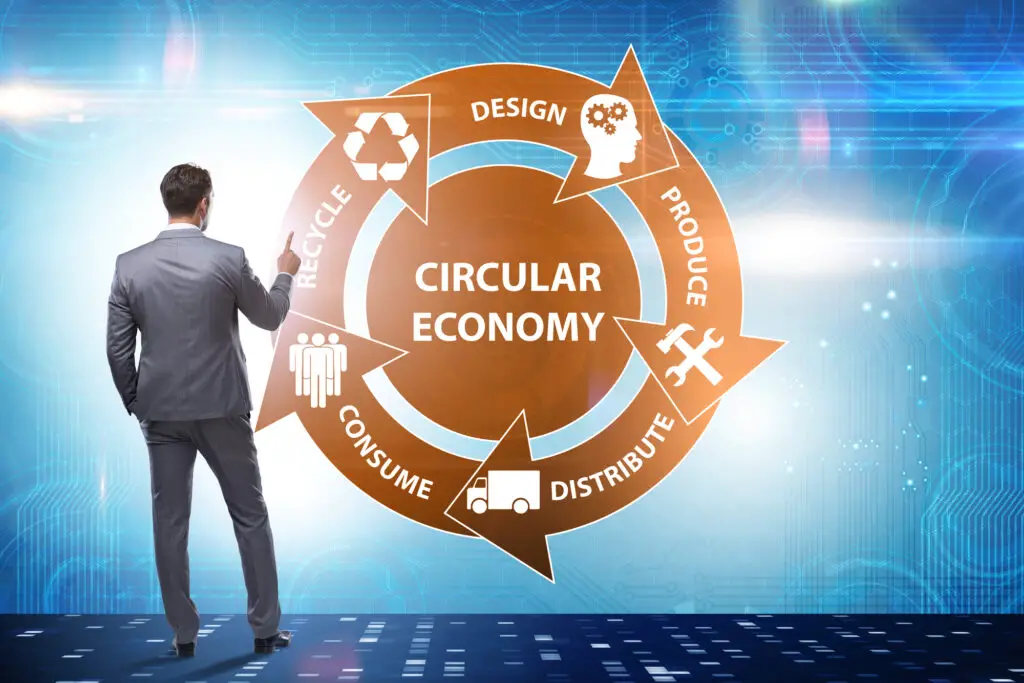 April 22 is Earth Day, which started in 1970 as a day to raise awareness of environmental issues. This year’s theme for Earth Day is “Planet vs. plastics,” with a goal of a 60% reduction in plastic production by 2040. Whether you’re a climate change activist or just someone concerned about protecting the environment, Earth Day is a good time to think about the Circular Economy and how your business can benefit from it.
April 22 is Earth Day, which started in 1970 as a day to raise awareness of environmental issues. This year’s theme for Earth Day is “Planet vs. plastics,” with a goal of a 60% reduction in plastic production by 2040. Whether you’re a climate change activist or just someone concerned about protecting the environment, Earth Day is a good time to think about the Circular Economy and how your business can benefit from it.
What’s the circular economy?
According to one source, “the circular economy is a model of production and consumption which involves sharing, leasing, reusing, repairing, refurbishing, and recycling existing materials and products as long as possible. In this way, the life cycle of products is extended.” In effect, there’s less waste and cost savings.
Boiling things down, the circular economy is based on 3 principles:
- Eliminate waste and pollution
- Circulate products and materials
- Regenerate nature
Think about the paper and the paper industry, where the principles of the circular economy can clearly be seen. The use of paper for documents is being largely replaced by the use of electronic formats, but we’re not a paperless society. For businesses that use paper, most re-use it in various ways, such as shredding unneeded printed pages to use as packing materials. Paper itself is recycled (check your next box of copying paper where you’ll likely see that the contents has been recycled). And paper companies continually replant trees to replace what’s cut down; sustainability is embraced.
The circular economy is in opposition to the current economy, which is the “linear economy,” the “throwaway economy,” and planned obsolescence.
How you can benefit from the circular economy
The circular economy is more than just recycling. It’s a new approach to goods and services. According to one source, which offers a very clear explanation of the circular economy, there are 8 advantages to the circular economy. The following is excerpted from this source:
- More attractive—sustainable—products. Consumers today appreciate this.
- Greater customer intimacy. This is because products are offered essentially as services. This means more contact with the customer (e.g., during repairs, returns, and upgrades).
- Lower costs. This is because products are meant to be reused, repaired, or refurbished. Eventually, the components are re-manufactured.
- Recurrent income sources. Waste becomes an asset.
- Greater resilience. Because businesses in a circular economy recover and recycle materials, they are better able to handle supply chain disruptions and also protect against price fluctuations.
- Greater product and component utility. Product use is increased, resulting in higher income per unit.
- Reduced production time. Businesses can meet demand by refurbishing rather than manufacturing. “One example can be found in wind power. Demand for wind turbines is currently so high that fulfilling orders take some manufacturers as long as two years. By contrast, an existing wind turbine can be refurbished and delivered in four months.”
- Climate and environmentally friendly. Extending the life of products and recycling them uses less energy.
Resources
You can find case studies, ideas, and courses on the circular economy from the Ellen Macarthur Foundation. You can also see the SME initiative from the foundation in London.
Other initiatives encouraging small businesses to be part of the circular economy include:
- Circular Economy SMEs (CESME). This is an initiative in the European Union.
- Green Business Network. It’s a membership organization in the U.S. for socially and environmentally responsible businesses. It offers Green Business certification. There are also how-to guides on getting started as a green business in various industries (e.g., sustainable personal care; financial advisors and planners; sustainable fashion).
- New York City’s Zero Waste Challenge. The challenge ran in 2016 (and winners are listed here), but the goal is sending zero waste to landfills by 2030.
Final thought
Mother Teresa said: “I only feel angry when I see waste. When I see people throwing away things we could use.”
Let this sentiment resonate on Earth Day and support a shift to a circular economy.
For more information related to sustainable business practices, see blogs here.


